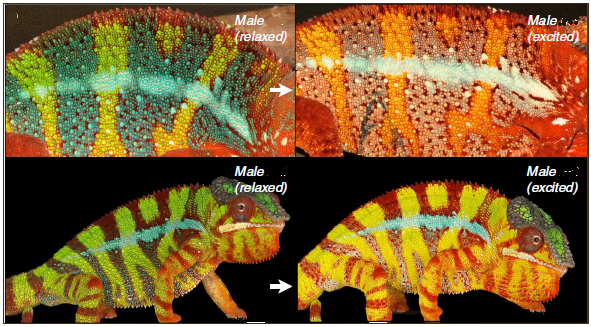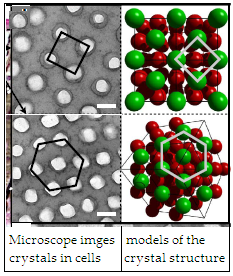The chameleon trick is found to be mechanical, rather than chemical, says S.Ananthanarayanan.
The natural world has been found to use great innovation in the use of colors, for identity, communication and camouflage. The colors found in plants are largely based on chemicals in leaves or petals, but in animals, more so with birds and insects, and in the butterfly especially, great variation of shade and pattern, not even possible with chemicals, is achieved by optical tricks. And the chameleon takes the lead, in being able to change colors at will!
This change in colors of the chameleon was considered to arise from dispersion or the coming together, in the skin of the animals, of light reflecting cells, which contain pigments. But Jérémie Teyssier, Suzanne V. Saenko, Dirk van der Marel and Michel C. Milinkovitch, of the University of Geneva, in the journal, Nature Communications, report the discovery of a different mechanism. It is found that the skin of the male chameleon contains two layers of a mesh of minute crystals, which have no affinity to colors, but whose orientation and separation affects the shades of light that the skin reflects. Stress or excitation brings about changes in the distances between the nanocrystals, which changes the wavelengths of light that are strongly reflected and thus the colors of the animal’s skin.
Biological pigments
The variety of colors found in plants comes from selective reflection of light by chemical factors present in cells. The main function of plants surfaces being collection of light for photosynthesis, the main color of plants is green the color of chlorophyl, which absorbs the yellow and blue wavelengths. Another coloring factor in plants is carotenoids, the red and yellow shades found in carrots. These assist photosynthesis and also help save the plant cells from damage. And then there are the anthocyanins (meaning flower blue) which take shades from red to blue, depending on the acidity of the medium, and serve to reflect light that has passed through the leaf or petal to parts that contain chlorophyll, for optimizing photosynthesis. Another group of pigments is the red or yellow Betalains, found where there are no anthocyanins, like in beetroot or bougainvillea

Coloration by pigments does not depend on the angle of light or the viewing angle, unlike structural coloration, found in birds and insects. Here, color is not because of absorption of wavelengths, but suppression of reflected components by interference of waves, like the rainbow colors seen on a thin sheet of oil spilt on water. Just as light waves of some colors interfere when reflected off the inner and outer and inner surfaces of the film of oil, rainbow effects arise on the thin layers, or step formation of reflecting surfaces on the wings of birds and insects. As the angle at which light falls on these surfaces, or the angle from which they are seen would affect which wavelengths get suppressed, there can be rapid change of colors or patterns as the animal moves.
Animals do not carry out photosynthesis, or need to attract bees or butterflies for pollination, and the role of colors in animals is mainly camouflage or to show aggression or to attract mates. Most of the action takes place in cells called chromatophores, or cells that contain pigment, which can be red, dark, as in black or yellow. The pigment expressed can be controlled and many animals, particularly marine animals, are able to make an extent of changes in colors. Many marine species also have fluorescent or bioluminescent structures on their scales. The squid is even known to harbor bacteria that glow to match surroundings, so that the host is not seen by predators.
Coloration in animals can also come from structures known as photonic crystals in the skin. These are patterns of microscopic crystals, which have no colors of their own, but affect the passage of particular wavelengths of light by their distribution, with distances between crystals being of about a quarter of the wavelength. In many marine species, such crystal filters create a variety of colors and modifications in the geometry of the reflecting surfaces have been suggested as a way of changing colors too.
The chameleon
Certain kinds of chameleon can display great changes of basic color, not just variation of shade, which could be explained by changes in the distribution of chromatophores. The panther chameleon, native of Madagascar, is one such. The chameleon is found to possess two types of dark pigment, which both sexes and all ages can control to strongly modulate the brightness of the skin. But adult males can do a lot more, with various combinations of white, red, green and blue skin and the ability to rapidly change color. In the presence of a male competitor or a potentially receptive female, a mature male panther chameleon can shift the background color of its skin from green to yellow or orange, while blue patches turn whitish and red becomes brighter, all within a couple of minutes and fully reversible

The Geneva researchers analysed the distribution of wavelengths and used high resolution videos to study the color changes. The specific color changes, from blue to green to red, were so marked that they were clearly not only due to pigment change within chromatophores and had to involve structural effects, like multilayer interference. Sensitive microscopic analysis then showed that the chameleon skin contained two layers of reflective cells, called iridophores, which contained a matrix of transparent crystals of different shapes and sizes. In the adult males, the upper layer was stocked with small, close packed, crystals, arranged in a triangular lattice.

The lattice of transparent crystals created a pattern of alternating path length for light and the effect was like that of a photonic crystal, which is an optical device that can block out a range of wavelengths. Now, further study of chameleon skin at times when it was blue or green (relaxed) and yellow or white (exited), showed that nano-crystals were of the same size, but the distances separating the crystals were about 30% greater when the animal was excited. As the nature of photonic crystals is that slightest change in geometry leads to large changes in the wavelengths suppressed, variation of crystal separation appeared to be the way the chameleon managed its color changes.
To test out this suggestion, the researchers took samples of chameleon skin in the excited (white) state and exposed the skin to chemical media of different salinity, to create pressures that would shrink the lattice to the relaxed state. “This treatment indeed results in a blue shift..” says the paper. “....furthermore, cell tracking during increase of extracellular osmolarity (ie, salinity) indicates that individual cells experience a gradual shift in color across the whole visible spectrum,” the paper adds. The group has followed up with computing the color-changing effects that a model optical crystal, with the same properties and dimensions of the chameleon skin lattice would show, and they find that this tallies with what is observed. The finding is thus strongly that the wide color changes of the chameleon come from physical changes in the layout of photonic crystal elements in the skin, rather than changes in pigments or even orientation of reflecting surfaces.
Another result of the study is that the second layer in the chameleon skin also contains crystals, which reflect in the infra-red or radiation that carries heat. As chameleons have evolved in environments of bright sunshine, the function of this layer appears to be regulation of the temperature of the animal in conditions of intense heat. “The organization of iridophores into two superposed layers constitutes an evolutionary novelty for chameleons that allows some species to combine efficient camouflage with spectacular display. Additional analyses are warranted to identify whether the deep layer of iridophores in chameleons further provide them with improved resistance to variable sunlight exposure,” the paper says.
------------------------------------------------------------------------------------------